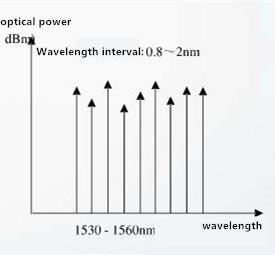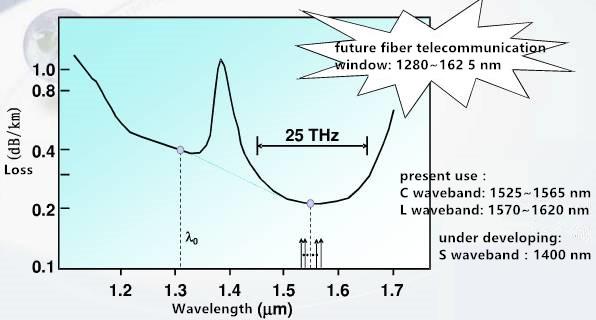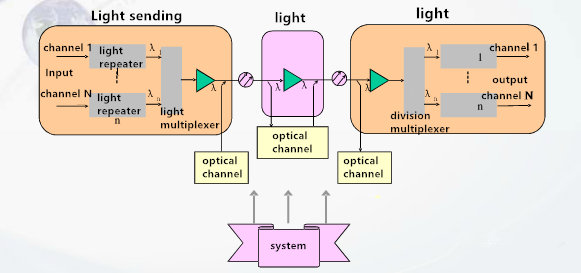- Related articles
- Optical Transceivers for Cisco SRW248G4-K9-EU Switch
- All Cisco ONS-SI-2G-I1's information (List price, Specs, Datasheet PDF, Compatibility matr
- All Cisco CWDM-GBIC-1590's information (List price, Specs, Datasheet PDF, Compatibility ma
- All Cisco SFP-10G-LR-S's information (List price, Specs, Datasheet PDF, Compatibility matr
- What Is GJYFJCH Fiber Optic Cable?
- All Cisco DS-SFP-FC-2G-LW's information (List price, Specs, Datasheet PDF, Compatibility m
- Optical Transceivers for Cisco WS-C2960S-48FPS-L Switch
- How to Test a Fiber Optic Transceiver?
- Optical Transceivers for Cisco WS-C2960X48LPDL-RF Switch
- Optical Transceivers for Cisco N3K-C3172TQ-XL Switch

Basic knowledge of DWDM
·WDM—multiplexing multi-light carriers carrying different information to one fiber to transmit (1510/1310 wavelength systems were used earlier)
·DWDM (Dense Wavelength Division Multiplexing) in 1550 nm window employs more wavelengths for wavelength division multiplexing (8, 16…)
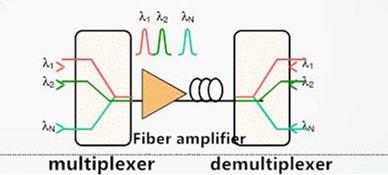
DWDM technology means that around the window of 1550 nm, dense multi-light carriers with a certain wavelength interval are employed within the range of beneficial wavelength provided by EDFA. These light carriers are respectively modulated by different digital signals, multiplexed to one fiber for transmission, thus improving the transmission capacity of each fiber.
·According to the specialties of fiber and EDFA, wavelength area of WDM system is selected as 1530 nm~1565 nm
·193.1 THz is selected as absolutely referenced frequency for its fine stability and high precision
·The same interval of passageway is that in frequency instead of the balanced interval in wavelength
The relation between DWDM and TDM
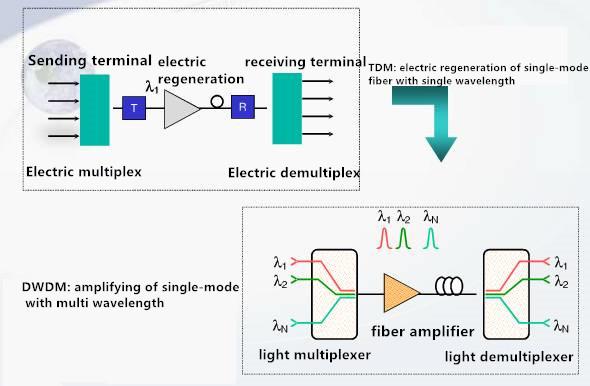
DWDM systematic drawing
What is the conversion between 100GHz and 0.08 nm of DWDM wavelength interval?
ITU-I said that in the first wave of DWDM,
f1 = 192.10THz
c=λ*f
c=299792458 m/s, light speed f=192.10 THz (T is the 12th power of 10)
λ=c/f, bring the numerical values of c and f, so
λ=1560.61 nm
When f1=192.10THz, λ1=1560.61nm
When f2=192.20THz, λ2=1559.79nm
When f3=192.30THz, λ3=1558.98nm
When f4=192.40THz, λ3=1558.17nm
the rest can be done in the same manner,
λ1-λ2=1560.61nm-1559.79nm=0.82nm
λ2-λ3=1559.79nm-1558.98nm=0.81nm
λ3-λ4=1558.98nm-1558.17nm=0.81nm
The 100 GHz wavelength terminal is around 0.8 nm
In a similar way, the 50 GHz wavelength terminal reflected on the wavelength is very similar to 0.4 nm bandwidth;
In a similar way, the 200 GHz wavelength terminal reflected on the wavelength is very similar to 1.6 nm bandwidth.





























































